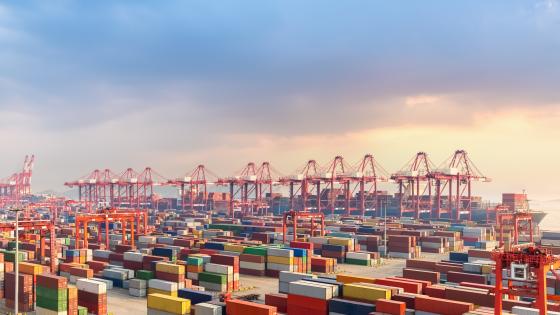The impact of tariff reductions or eliminations on prices, or ‘tariff pass-through’, has long been studied in the international economics literature. Tariff pass-through is a vital issue when considering who benefits from trade liberalisation and to what extent. Several studies have investigated tariff pass-through from the perspective of producers (Feenstra 1989, Ludema and Yu 2016, Görg et al. 2017, Cadot et al. 2005, Olarreaga and Ozden 2005, Ozden and Sharma 2006, Cirera 2014) and the perspective of consumers (Porto 2006, Nicita 2009, Han et al. 2016, Ural Marchand 2012). To summarise, the literature has shown that both producers and consumers enjoy the benefits of a tariff reduction.
In general, goods go from a producer in a foreign country (i.e. an exporter) to a household in a home country through wholesalers, retailers, and other local players (e.g. distribution services providers). Although the existing studies have investigated the tariff rent allocation for producers and consumers as noted above, no studies have empirically explored it from the perspective of wholesalers. In Baek et al. (2019), we fill this gap by employing firm-level data for Japanese wholesalers.
Before introducing our empirical results, let us summarise Japan’s tariff rate trends. Figure 1 shows the simple average of Japan’s applied tariff rates on imports from 175 countries for two different groups of products, one group consisting of products with tariff rates between 10% and 20% in 1988, and the other with tariff rates higher than 20%. More drastic change can be observed for products with a higher average level in 1988. Overall, Japan’s tariffs gradually declined. The reduction in the 1990s was mainly driven by the reduction of most favoured nation (MFN) rates following the agreement made in the Uruguay Round negotiations. For Japan, MFN tariffs had already been eliminated for 42% of the total tariff lines by the latter half of the 2000s, and they have remained more or less unchanged since then. The slight decrease in the average from the latter half of the 2000s was due to an enactment of a number of regional trade agreements (RTAs). The sharp decrease in 2007 was because Japan eliminated generalised system of preferences (GSP) tariff rates on almost all products from the least developed countries, following the Hong Kong Ministerial Declaration in December 2005.
Figure 1 Simple average of Japan’s applied tariffs on imports from 175 countries.
Source: Baek et al. (2019)
We begin by investigating tariff pass-through in import and consumer prices because no rigorous empirical analysis of these pass-throughs has been conducted for Japan so far. To investigate tariff pass-through in imports, we explored the relationship between import prices and tariff rates by using data on Japanese imports from 175 countries during the period 1988–2014. We examined the tariff pass-through in consumer prices by examining the relationship between the consumer price and the tariff rate. The consumer price is computed by dividing total family expenditure by total quantity using Japan’s Family Income and Expenditure Survey from 1996 to 2006 (Ministry of Internal Affairs and Communications). From the analysis, we found that a 1% reduction in tariff rates raises import prices by 0.49% and decreases consumer prices by 0.08%.
Next, we investigate the tariff pass-through in wholesaling by examining the effect of tariffs on the margin ratio, the ratio of sales minus procurements to sales. This ratio is one of the typical indicators of wholesalers’ performance used in the field of marketing research. Let X be the ratio of the sales price to the procurement price. When sales and procurement quantities are the same, a one percentage-point increase in the margin ratio is equivalent to an X% increase in the sales price relative to the procurement price. Our main dataset is the Census of Commerce for the years 1997, 2002, and 2007 (Ministry of Economy, Trade and Industry), conducted for all firms engaged in wholesale and retail trade. To investigate the tariff pass-through in wholesaling, we focused on the wholesalers who procure their products from foreign countries and sell to the domestic market.
We used an instrumental variable (IV) method to address a measurement error problem, which resulted from the procedure we used to match multiple 9-digit harmonised system codes for imports to the 5-digit codes used in the census. As an instrument, we used Japan’s revealed comparative advantage index. We found that importing wholesalers significantly increase their margin ratio against a tariff reduction. On average, a 1% reduction in tariffs raises the margin ratio by approximately 0.25 percentage points. This magnitude is equivalent to a rise in sales prices relative to procurement prices of approximately 0.34%.
Although one should be cautious about comparing the size of margins for different players, our results suggest that wholesalers in the importing country enjoy a smaller portion of tariff rent than producers in the exporting country but a larger portion than consumers in the importing country. It should be noted that our results for consumer prices include other effects on domestic product prices in addition to those from the prices of imports. Therefore, tariff pass-through in the consumer prices of imported products may be higher than our estimate. The small benefits observed for consumers are consistent with the public view in Japan that consumers only obtain small benefits from import liberalisation. The recent increase in business-to-consumer cross-border e-commerce may decrease the role of wholesalers and retailers, enabling consumers to obtain larger benefit from trade liberalisation, which may be realised through RTAs.
Editor‘s note: Editor’s note: The main research on which this column is based (Baek et al. 2019) first appeared as a Discussion Paper of the Research Institute of Economy, Trade and Industry (RIETI) of Japan
References
Baek, Y, Hayakawa, K Tsubota, S Urata and K Yamanouchi (2019), “Tariff Pass-through in Wholesaling: Evidence from Firm-level Data in Japan”, Research Institute of Economy, Trade and Industry (RIETI), Discussion papers 19-E-064.
Cadot, O, C Carrere, J de Melo and A Portugal-Perez (2005), “Market Access and Welfare under Free Trade Agreements: Textiles under NAFTA”, World Bank Economic Review 19(3): 379-405.
Cirera, X (2014), “Who Captures the Price Rent? The Impact of European Union Trade Preferences on Export Prices”, Review of World Economics 150(3): 507-527.
Feenstra, R (1989), “Symmetric Pass-through of Tariffs and Exchange Rates under Imperfect Competition: An Empirical Test”, Journal of International Economics 27(1-2): 25-45.
Görg, H, L Halpern and B Muraközy (2017), “Why Do within Firm-product Export Prices Differ across Markets?”, The World Economy 40(6): 1233–1246.
Han, J, R Liu, B Ural Marchand, and J Zhang (2016), “Market Structure, Imperfect Tariff Pass-through, and Household Welfare in Urban China”, Journal of International Economics 100: 220-232.
Ludema, R and Z Yu (2016), “Tariff Pass-Through, Firm Heterogeneity and Product Quality”, Journal of International Economics 103: 234–249.
Nicita, A (2009), “The Price Effect of Tariff Liberalization: Measuring the Impact on Household Welfare”, Journal of Development Economics 89(1): 19–27.
Olarreaga, M and C Ozden (2005), “AGOA and Apparel: Who Captures the Tariff Rent in the Presence of Preferential Market Access?”, The World Economy 28(1): 63-77.
Ozden, C and G Sharma (2006), “Price Effects of Preferential Market Access: Caribbean Basin Initiative and the Apparel Sector”, World Bank Economic Review 20(2): 241-259.
Porto, G (2006), “Using Survey Data to Assess the Distributional Effects of Trade Policy”, Journal of International Economics 70(1): 140–160.
Ural Marchand, B (2012),“Tariff Pass-through and the Distributional Effects of Trade Liberalization”, Journal of Development Economics 99(2): 265-281.








